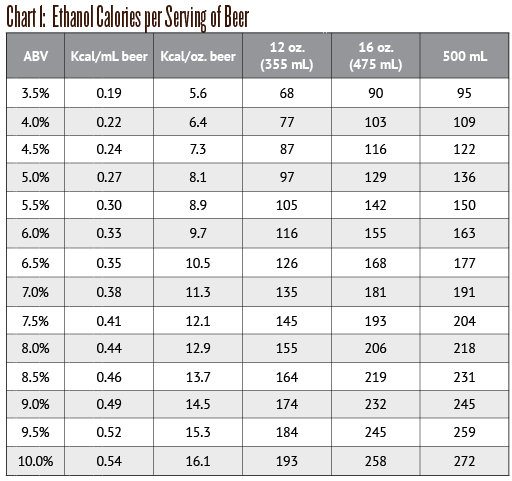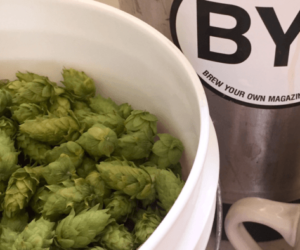Counting Calories & Carbs

Beer is food and as food, it contains calories. Much confusion about drinking beer and losing weight exists and, thanks to a recent diagnosis of type II diabetes, I have become very interested in the carbohydrate content and calories in my beer. My brewing software provides the estimated grams of carbohydrate and calories per pint of homebrew, which started me down a path of wanting to learn more about how calories and carbohydrates in beer can be estimated.
The macronutrients in beer are alcohol and carbohydrates. The carbohydrates in beer are small glucose polymers and dextrins — complex sugars yeast can’t metabolize. Unfortunately, beer provides very few other nutrients, hence the term empty carbs. In the past, beer was a valuable source of energy. Today we in developed countries have enough food that beer is no longer a dietary necessity, but a luxury.
Estimating Calories
The Oxford Companion to Beer pro-vides a formula for estimating calories
in beer:
Kcal = 6.9 kcal / g x %ABW + 4 kcal/g x (RE – ash)
Where:
Kcal = kilocalories.
ABW = the alcohol by weight.
RE = real extract in degrees Plato.
ash = an experimentally-derived factor representing mineral solids in the beer, generally set to 0.1.
The two terms (RE and ash) represent the calories from alcohol and the calories from carbohydrates and proteins per 100 mL of beer because both the ABW and the RE are percentages.
We’ll start by estimating the calories provided by alcohol. Ethanol provides 6.9 Calories per gram, technically kilocalories, or the energy required to heat a kilogram of water one degree Celsius. To estimate the number of calories from alcohol in a beer, first calculate the number of grams of alcohol in the beer. In the U.S., beer strength is given in alcohol by volume (ABV). ABV can be converted to ABW by multiplying the volume of beer by %ABV resulting in milliliters of alcohol. Convert milliliters to grams by multiplying milliliters by 0.79 g/mL, the density of ethanol. Then multiply the grams of alcohol in the beer by 6.9 Calories/gram. To convert ounces of beer to milliliters, multiply the ounces of beer by 29.57 mL/oz. A 12-oz. bottle is 355 mL, a pint is 473 mL.
Example: Let’s calculate the calories from alcohol in a 12-ounce (355-mL) bottle of 5.5% ABV beer. The ABW is 5.5% x 0.79 = 4.3%. The calories in 100 mL are 6.9 Kcal/g x 4.3 g/100mL = 29.7 Kcal/100 mL. The calories from alcohol in a 12-ounce (355-mL) bottle are 3.55 x 100 mL/bottle x 29.7 Kcal/100 mL = 105 Kcal/bottle from alcohol.
Or, if you’d rather not do the math, refer to Chart 1.

Estimating Carbohydrates
Beer’s carbohydrates are comprised of the sugars and dextrins remaining after fermentation. If you know the beer’s original and final gravities, and as a homebrewer you should know these quantities, you can estimate the beer’s carbohydrates by estimating the real extract (RE), the percentage of dissolved solids remaining in a beer after fermentation. This is represented by the second term in the equation given earlier.
The key to estimating the carbohydrates in beer is understanding the RE, the amount of carbohydrate remaining in the beer after fermentation. Balling provides a formula to estimate the RE based on the original extract (OE) and the apparent extract (AE), the gravity measured after fermentation is complete, measured in degrees Plato. Note that for estimation purposes, degrees Plato are roughly equivalent to gravity points divided by four:
RE = (0.18 x OE) + (0.82 x AE) (where the result is in grams/100 mL).
Example: Estimate the extract in a 12-ounce (355-mL) bottle of a beer starting at 14 °P and finishing at 4.5 °P. RE = (0.18 x 14 °P) + (0.82 x 4.5 °P), or 6 g/100 mL. To scale to a 12-ounce (355-mL) bottle, multiply by 3.55 mL resulting in an estimate of 22.0 g real extract per bottle.
According to the Michigan Brewer’s Guild, the formula produces most accurate results when the Real Degree of Fermentation (RDF), the actual percentage of extract converted to alcohol, is near 65%. A full-bodied beer may have an RDF of 50%, a highly attenuated beer may have an RDF over 80% but, for a useful estimate of the calories or carbs in beer, assuming an RDF of 65% yields a close-enough estimate. The resultant RE is in degrees Plato, the percentage of carbohydrate remaining in 100 grams of beer. Subtract the ash from the RE to obtain the grams of carbohydrate in 100 mL of beer, then multiply by 4 Kcal/g to estimate the caloric contribution from carbohydrate.
Example: A beer with an estimated RE of 4.8 °P provides 4.7 grams of carbohydrate per 100 grams of beer (4.8 g/100 mL – 0.1g/100 mL). Multiply by 4 Kcal/g, then by 3.5 x 100 mL/bottle to obtain an estimate of 66 Kcal per 12-ounce (355-mL) bottle from carbohydrates.
Chart 2 shows the grams of carbohydrate in a 12-ounce (355-mL) beer given the original and final gravities using the SG scale used by most homebrewers:

If you are interested in the grams of carbohydrate in the beer, divide the carbohydrate calories by four Kcal/g to obtain an estimate. Or if your interest is the total calories in a 12-ounce (355-mL) beer, add the alcohol calories and the carbohydrate calories. Or you can refer to Chart 3:

Brewing Low-Cal & Low-carb Beers
If, as I do, you need to control both calorie and carbohydrate intake, we have some tools in the box to control one or both of the factors. To lower overall calories, simply brew a lighter beer. Less original extract means fewer calories. You can brew some very flavorful low-alcohol beers such as an English mild, Piwo Grodziskie, session IPA, Kölsch, and more. You can control the carbs by managing the mash temperature (higher temperatures result in more carbohydrate but less alcohol and vice versa). You can also use enzymes to degrade the starches to sugars, which then are fermented to alcohol, lowering the carbs in the beer. For much more on this subject, refer to: https://byo.com/mr-wizard/crafting-low-carb-beers/
By knowing the macronutrients in beer and how to control them, a homebrewer can keep both the calories and carbohydrates to a level required for their dietary needs.
Measurements of Wort Gravity and Extract (sidebar)
Gravity is measured as specific gravity, a dimensionless ratio of the mass of the solution to the mass of an equal volume of water at the same temperature, meaning that 100 mL of a 1.048 SG wort weighs 1.048 times that of 100 mL of water. Specific gravity is commonly used by British brewers or brewers using the British brewing tradition, including most U.S. homebrewers.
Extract is commonly measured using the Plato scale, a measurement of dissolved solids in wort. The measurement is defined as grams of extract per 100 grams of wort at 20 °C (68 °F). As an example, 100 g of 12 °P wort contains 12 grams of extract. The Plato scale is used by most brewers worldwide with the notable exception of British brewers or brewers using British tradition.
The Brix, or Balling Scale, is effectively the same as the Plato scale, with Brix or Balling more commonly used in the wine industry. The difference between Brix/Balling and Plato are the reference temperatures of the wort (20 °C/68 °F for Plato and 17.5 °C/63.5 °F for Brix/Balling). At the homebrew scale, Brix, Balling, and Plato can be considered equivalent. As a rough approximation, to convert from Plato to gravity points, multiply the degrees Plato by four.
Because the units for both Plato and Brix are grams/100 grams, they may be treated as percentages in calculations.
Source: The Oxford Companion to Beer
Piwo Grodziskie
(5 gallons/19 L, all-grain)
OG = 1.037 FG = 1.007
IBU = 30 SRM = 4 ABV = 3.9%
Ingredients
7 lbs. (3.2 kg) oak-smoked wheat malt
0.6 lb. (0.27 kg) German pale ale malt
14 oz. (0.4 kg) rice hulls
5.6 AAU Saaz hops (60 min.) (1.6 oz./45 g at 3.5% alpha acids)
7 AAU Saaz hops (0 min.) (2 oz./58 g at 3.5% alpha acids)
Wyeast 1007 (German Ale), White Labs WLP029 (German/Kölsch Ale), or SafAle K-97
¾ cup table sugar (if priming)
Step by Step
This recipe uses reverse osmosis (RO) water adjusted to 71 ppm Ca2+, 33 ppm Mg2+, 1 ppm Na+, 124 ppm Cl–, 202 ppm SO42-, assumed 5 ppm hardness as CaCO3, 1 mL 88% lactic acid or equivalent acidulated malt. The high magnesium level is characteristic of the water of Grodzisk, Poland.
Dough-in and rest using 4.5 gallons (17 L) of treated liquor for an hour at 150 °F (66 °C). Alternately, a step mash using the following steps may be used: 100 °F (38 °C), 30 min.; 125 °F (52 °C), 45 min.; 145 °F (63 °C), 45 min.; 158 °F (70 °C), 30 min.; 170 °F (77 °C), 10 min. mash-out. If desired, use a decoction to raise the mash temperature to the final step. Drain into kettle. Batch or fly sparge with 4-gallons (15-L) water at 170 °F (77 °C), run off to collect 6.75 gallons (26 L) of wort.
Boil the wort for 90 minutes assuming 1 gallon-per-hour (3.8 Liter-per-hour) boil-off rate, adding hops per the schedule. At 10 minutes, add 1 whirlfloc tab and 2 g yeast nutrient (optional). After the boil, give the wort a long stir to create a whirlpool and let settle for 20 minutes.
Chill to 60 °F (16 °C). If not using dry yeast, oxygenate or aerate. Pitch an adequate quantity of yeast. Ferment at 65 °F (18 °C) for three days or until half of fermentation is complete, then allow temperature to rise to a maximum of 68 °F (20 °C). After a short conditioning, prime and bottle or keg to 3.5 volumes CO2.
Notes:
Though possibly difficult to find, if available substitute Marynka hops for bittering and Lublin hops for flavor. Unfortunately there is no extract substitute for smoked malts available in most places.
Calorie calculation per 12 oz. (355 mL):
KcalAlc = 6.9 kcal / g x (0.79 g/mL x 3.9% ABV) x 3.5 = 74 Kcal
RE = [(0.18 x 9.25 g/100g) + (0.82 x 1.75 g/100g)] = 3.1 g/100g
KcalCarb = 4 Kcal/g x (3.1g/100g – 0.1g/100g) x 3.5 = 42 Kcal
GCarb = 42 Kcal / 4 Kcal/g = 10.5 g
Kcaltotal = KcalAlc + KcalCarb = 74 Kcal + 42 Kcal = 116 Kcal



